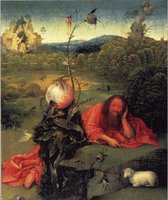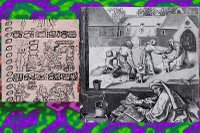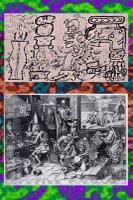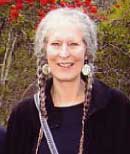Wednesday, May 23, 2007
Friday, August 18, 2006
(15) infrared reflectography



The results of infrared reflectography are even more striking for The Garden of Delights/El Jardín de las Delicias, where it appears that there was once a giant lizard in the right panel. It could almost be the remnant of a completely different painting, except that it resembles an illustration of a salamander in the Margarita Philosophica, which has already been mentioned in connection with memory images. It makes sense as an illustration in a schoolboy's text (since Murner's memory images also included interesting things like bugs), and also as part of a series of images having to do with alchemy. But in the context of New World images, it might have been regarded as potentially offensive. There were a few Arawak words that Europeans learned early and have never forgotten, including (in their English spellings) potato, hurricane, hammock, and iguana. The word iguana is said to be a harmless transcription of the Arawak word iwana, but it sounds just like "y Juana," and it seems reasonable to suppose that if Juana chanced to see an iguana or a picture of one, she would not be amused. She also may have had reason to dislike or at least mistrust Peter Martyr, the Italian diplomat who reported news from the New World, including new words, and at one point was also assigned to report on Juana's sanity or lack of sanity. He described the "iguana serpents" as looking like crocodiles.
There is an exhibition showing the results of infrared photography at the Museo Del Prado, through November of this year, The Hidden Line/El Trazo Oculto.
(14 infrared reflectography



Juana is almost entirely absent from the literature on Hieronymus Bosch but she was in the Netherlands from 1496 to 1506 as the wife of Felipe el Hermoso, and he signed a contract to buy a Last Judgment triptych (which if it was ever painted is now lost), making him the artist's only identified patron. Also, Juana's mother Isabel la Católica and her sister-in-law Margaret of Austria both owned Bosch paintings. It was news to art historians a few years ago when it was established that someone was painted out of a Bosch or Bosch-studio painting and replaced with a plant, and it seems as though the possibility that Juana knew of such things cannot be ruled out. It looks as though, for whatever reason, the artist's goal was to make the painted-out person look as ridiculous as possible.
The drawing and photograph reproduced here are from Roger van Schoute and Monique Verboomen, Jérôme Bosch. There is also a detailed article on the technical study by Maria Dolores Fuster Sabater.
Thursday, August 17, 2006
(13) why John the Baptist

 This is a connection that will make sense once the Nahuatl chronology is explained. In the Nahuatl chronology, the Eden scene (part of or perhaps the whole left panel of the triptych) corresponds to the 1524 arrival of Franciscan missionaries in New Spain, where they baptized people in great numbers. Isabel Mateo Gomez's complicated explanation of how if the man in the cave is John the Baptist, the woman is Eve and the person in the back of the cave might be Adam, is easier to understand once the Eden scene is read as an allegory of baptism. (In other words, Carlos I and Juana I were co-regents of Spain, and the Spanish were in New Spain for the purpose of baptizing people.) Juana is still more impressive than her son the emperor since she is like Eve, the ancestor of everyone.
This is a connection that will make sense once the Nahuatl chronology is explained. In the Nahuatl chronology, the Eden scene (part of or perhaps the whole left panel of the triptych) corresponds to the 1524 arrival of Franciscan missionaries in New Spain, where they baptized people in great numbers. Isabel Mateo Gomez's complicated explanation of how if the man in the cave is John the Baptist, the woman is Eve and the person in the back of the cave might be Adam, is easier to understand once the Eden scene is read as an allegory of baptism. (In other words, Carlos I and Juana I were co-regents of Spain, and the Spanish were in New Spain for the purpose of baptizing people.) Juana is still more impressive than her son the emperor since she is like Eve, the ancestor of everyone. There is also some irony, since the inhabitants of the New World were likely to be more skeptical than Adam and Eve were on the sixth day of Creation when they were only a few hours old. It is not clear to what extent the group in the cave relates to New World histories involving caves and mothers of twins (Juana actually had six children including two sons).
There is also some irony, since the inhabitants of the New World were likely to be more skeptical than Adam and Eve were on the sixth day of Creation when they were only a few hours old. It is not clear to what extent the group in the cave relates to New World histories involving caves and mothers of twins (Juana actually had six children including two sons).
(12) memory and Juana


 In a 1963 article, Isabel Mateo Gomez observed that the man in the cave could be identified as Saint John the Baptist, shown here in a picture from a Book of Hours that belonged to Juana and in a painting by Hieronymus Bosch or from his studio. This appears to be one of three possible correct interpretations: Samuel, Samson, and Saint John the Baptist, all of whom had long hair in connection with the Nazarite vow. Each of their biographies starts with the story of their mother, a barren woman who prays for a child. This means that in The Garden of Delights/El Jardín de las Delicias, Juana can be identified with Hannah, the mother of Samuel, the mother of Samson (whose name is not recorded), and Elizabeth, the mother of John the Baptist.
In a 1963 article, Isabel Mateo Gomez observed that the man in the cave could be identified as Saint John the Baptist, shown here in a picture from a Book of Hours that belonged to Juana and in a painting by Hieronymus Bosch or from his studio. This appears to be one of three possible correct interpretations: Samuel, Samson, and Saint John the Baptist, all of whom had long hair in connection with the Nazarite vow. Each of their biographies starts with the story of their mother, a barren woman who prays for a child. This means that in The Garden of Delights/El Jardín de las Delicias, Juana can be identified with Hannah, the mother of Samuel, the mother of Samson (whose name is not recorded), and Elizabeth, the mother of John the Baptist.  The picture provides an example of a simple memory system that consists of just remembering how many items there are to remember. Most of the Rhetorica ad Herennium follows this system, starting near the beginning with "three kinds of causes which the speaker must treat: Epideictic, Deliberative, and Judicial." The three possible interpretations also draw attention to the beginning of the story and to the mother as the heroine, as in a 1645 painting by Jan Victors of Samuel and Hannah.
The picture provides an example of a simple memory system that consists of just remembering how many items there are to remember. Most of the Rhetorica ad Herennium follows this system, starting near the beginning with "three kinds of causes which the speaker must treat: Epideictic, Deliberative, and Judicial." The three possible interpretations also draw attention to the beginning of the story and to the mother as the heroine, as in a 1645 painting by Jan Victors of Samuel and Hannah.
Friday, August 11, 2006
(11) memory and Charles V

 Memory could also be depicted by Charles V’s emblem of two columns (shown here in a later illustration), since the chapter on memory in the Rhetorica ad Herennium suggested visualizing a scene in an intercolumniation, that is in the space between two columns. The tapestry copies of The Garden of Delights/El Jardín de las Delicias were “improved” by the addition of two columns that could either allude to Charles V, or to the ars memoria in the Rhetorica ad Herennium. But if Memory is only part of the virtue of Prudence, and if (as Bruegel seems to have suggested) Juana was an embodiment of Prudence, even with the columns the triptych is still mostly about Juana. Even though all three panels include events in the past, they also represent past, present, and future, that is memoria, intelligentia, and providentia, all parts of Prudence.
Memory could also be depicted by Charles V’s emblem of two columns (shown here in a later illustration), since the chapter on memory in the Rhetorica ad Herennium suggested visualizing a scene in an intercolumniation, that is in the space between two columns. The tapestry copies of The Garden of Delights/El Jardín de las Delicias were “improved” by the addition of two columns that could either allude to Charles V, or to the ars memoria in the Rhetorica ad Herennium. But if Memory is only part of the virtue of Prudence, and if (as Bruegel seems to have suggested) Juana was an embodiment of Prudence, even with the columns the triptych is still mostly about Juana. Even though all three panels include events in the past, they also represent past, present, and future, that is memoria, intelligentia, and providentia, all parts of Prudence.
(10) memory, prudence, and Juana la Loca

 Another Bruegel print portrays a personification of the virtue of Prudence (Prudentia) in such a way as to illustrate how Juana could be regarded as an embodiment of that virtue. In the print Prudence is carrying a coffin as a reminder of death, and in an 1877 history painting in the Museo del Prado of Doña Juana la Loca by Francisco Pradilla, Juana is shown with the coffin of her late husband Felipe el Hermoso on the famous long journey across Spain to bury him in Granada.
Another Bruegel print portrays a personification of the virtue of Prudence (Prudentia) in such a way as to illustrate how Juana could be regarded as an embodiment of that virtue. In the print Prudence is carrying a coffin as a reminder of death, and in an 1877 history painting in the Museo del Prado of Doña Juana la Loca by Francisco Pradilla, Juana is shown with the coffin of her late husband Felipe el Hermoso on the famous long journey across Spain to bury him in Granada.The image of Juana as Prudence relates to the memory systems in The Garden of Delights/El Jardín de las Delicias since according to Cicero, Memory was a part of Prudence:
Prudence is the knowledge of what is good, what is bad and what is neither good nor bad. Its parts are memory, intelligence, foresight (memoria, intelligentia, providentia). Memory is the faculty by which the mind recalls what has happened. Intelligence is the faculty by which it ascertains what is. Foresight is the faculty by which it is seen that something is going to occur before it occurs. (see note)
Besides the allusion to Juana, the only suggestion in Bruegel’s print that Prudence includes memory is the way she is shown looking at what is behind her in a rear-view mirror. The caption defines Prudence more narrowly as thinking about the future:
SI PRVDENS ESSE CVPIS, IN FVTVRVM PROSPECTVM OSTENDE, ET QUAE POSSVNT CONTINGERE, ANIMO TVO CUNCTA PROPONE.
If you wish to be prudent, think of the future, and put your mind to all possible contingencies. (see note)
Tuesday, August 01, 2006
(9) alchemy

On the other hand, Bruegel might have confused an almanac illustration and an alchemy book on purpose in order to lump together ancient words, names, and book titles starting with the Arabic word al. The impoverished alchemist is reduced to leaving all that behind and applying for public charity. But in the Americas the term reducción specifically meant the reorganization of Indians under the missionary system, even if it sounded like part of the definition of some alchemical process. The picture-within-a-picture shows what reducción would look like in the Netherlands, and the larger picture shows it as a consequence of spending too much time and money on alchemy.
The print was first published with a Latin caption having to do with minerals and clouds, and there were two different later versions with French and Dutch captions (see note).
Monday, July 31, 2006
(8) alchemy


At least one of Bruegel's "explanations" is misleading. His print of The Alchemist appears to be based on the Dresden Codex, which was also apparently a source for The Garden of Delights/El Jardín de las Delicias. Another image on the same page appears to have been a model for the painting of The Pedlar (by an unidentified artist), which Bruegel turned into The Beekeepers. But if anyone thought the person in the Dresden Codex picture really was an alchemist, they were incorrect since the person is burning copal incense for a ceremony.
Friday, July 21, 2006
(7) triptych format and center panel

 The simplest way to describe the center panel is to say that it represents the general idea of a special day in a religious calendar, specifically the Sabbath and also including images of a series of events in the Jewish calendar. The triptych format illustrates Christian and Jewish concepts of time, including beginning, end, and the seven-day week, which were news to Americans. The festivals are recognizable even though people are not all behaving as they should. This is another theme that Bruegel represented more clearly, in a print that shows one festival and a range of good and bad behavior.
The simplest way to describe the center panel is to say that it represents the general idea of a special day in a religious calendar, specifically the Sabbath and also including images of a series of events in the Jewish calendar. The triptych format illustrates Christian and Jewish concepts of time, including beginning, end, and the seven-day week, which were news to Americans. The festivals are recognizable even though people are not all behaving as they should. This is another theme that Bruegel represented more clearly, in a print that shows one festival and a range of good and bad behavior.
